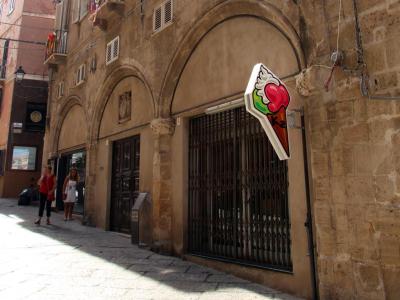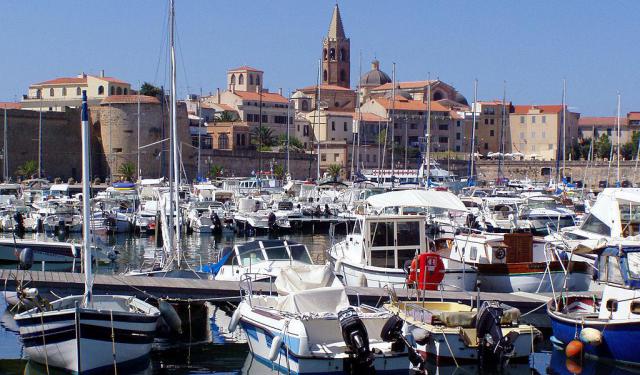
Palazzo Peretti (Peretti Palace), Alghero
The Peretti Palace stands as a testament to the city’s rich historical and architectural heritage. Constructed in the 15th century by the noble Guyo Duran family, the palace is an exemplary example of Gothic-Catalan style. Its historical significance is underscored by its continued ownership by the Peretti family, who acquired the building in the 18th century after it was purchased from the original owners.
The façade of Peretti Palace is particularly striking, featuring a grand wooden door that serves as a focal point for the building’s exterior. This door is flanked by intricately designed stone elements that highlight the craftsmanship of the period. The main façade, facing Roma Street, is composed of square-shaped sandstone blocks, which contrast with the plastered surfaces of the other parts of the building. This combination of materials provides a distinctive character and historical depth to the palace.
Despite its age, the Peretti Palace has maintained its architectural integrity, with the main facade remaining a prominent feature of the city’s landscape. The building’s Gothic-Catalan elements are evident in the decorative details and the overall layout, reflecting the style and sensibilities of the era in which it was built.
The façade of Peretti Palace is particularly striking, featuring a grand wooden door that serves as a focal point for the building’s exterior. This door is flanked by intricately designed stone elements that highlight the craftsmanship of the period. The main façade, facing Roma Street, is composed of square-shaped sandstone blocks, which contrast with the plastered surfaces of the other parts of the building. This combination of materials provides a distinctive character and historical depth to the palace.
Despite its age, the Peretti Palace has maintained its architectural integrity, with the main facade remaining a prominent feature of the city’s landscape. The building’s Gothic-Catalan elements are evident in the decorative details and the overall layout, reflecting the style and sensibilities of the era in which it was built.
Want to visit this sight? Check out these Self-Guided Walking Tours in Alghero. Alternatively, you can download the mobile app "GPSmyCity: Walks in 1K+ Cities" from Apple App Store or Google Play Store. The app turns your mobile device to a personal tour guide and it works offline, so no data plan is needed when traveling abroad.
Palazzo Peretti (Peretti Palace) on Map
Sight Name: Palazzo Peretti (Peretti Palace)
Sight Location: Alghero, Italy (See walking tours in Alghero)
Sight Type: Attraction/Landmark
Guide(s) Containing This Sight:
Sight Location: Alghero, Italy (See walking tours in Alghero)
Sight Type: Attraction/Landmark
Guide(s) Containing This Sight:
Walking Tours in Alghero, Italy
Create Your Own Walk in Alghero
Creating your own self-guided walk in Alghero is easy and fun. Choose the city attractions that you want to see and a walk route map will be created just for you. You can even set your hotel as the start point of the walk.
Alghero's Old Palaces
Alghero, a historical gem on the northwest coast of Sardinia, is home to some of Italy's most significant architectural monuments. This is evident in the city's remarkable collection of old palaces, showcasing narratives that span centuries.
Carcassona Palace, dating back to the mid-1400s, stands out with its mix of influences from Valencia, Naples, Palermo, and Sardinia. A former... view more
Tour Duration: 1 Hour(s)
Travel Distance: 1.0 Km or 0.6 Miles
Carcassona Palace, dating back to the mid-1400s, stands out with its mix of influences from Valencia, Naples, Palermo, and Sardinia. A former... view more
Tour Duration: 1 Hour(s)
Travel Distance: 1.0 Km or 0.6 Miles
Alghero Introduction Walking Tour
Alghero, a charming coastal town in Sardinia, Italy, is a unique historical place where the Sardinian and Catalan cultures united.
The area’s history stretches back way before Christian times. The Phoenicians arrived here in the 8th century BC, establishing a metalworking settlement called Saint Imbenia.
Later, this strategic Mediterranean location attracted the Genoese Doria family, who... view more
Tour Duration: 2 Hour(s)
Travel Distance: 1.6 Km or 1 Miles
The area’s history stretches back way before Christian times. The Phoenicians arrived here in the 8th century BC, establishing a metalworking settlement called Saint Imbenia.
Later, this strategic Mediterranean location attracted the Genoese Doria family, who... view more
Tour Duration: 2 Hour(s)
Travel Distance: 1.6 Km or 1 Miles


